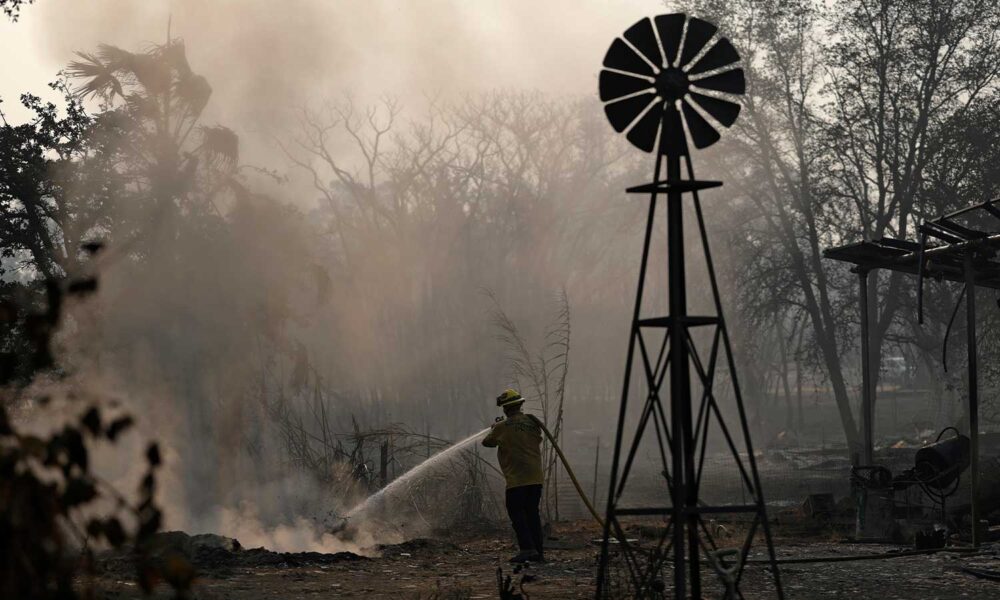This week in Danger Season:
- Lightning strikes ignite fires across abnormally dry parts of California
- Air quality and extreme heat collide on the West Coast
- Research sharpens the connections between climate change and extreme wildfire weather
This week in Danger Season, large numbers of wildfires have ignited and spread across the western United States and southwestern Canada and the National Interagency Fire Center has raised their preparedness level to 4, illustrating the growing demands of the fire season. New research dives deeper into how climate change is driving wildfire activity across the world, adding to the growing body of evidence highlighting the dangerous connections between heat-trapping emissions and wildfires.
Tinder meets spark
Lightning ignites multiple wildfires amid drought and extreme heat
- On Tuesday in California, thousands of lightning strikes ignited more than 20 wildfires in abnormally dry areas across central and northern parts of the state. Windy conditions following ignition led to rapid fire growth in some areas, prompting evacuations across several counties, including Tuolumne, Calaveras, and Stanislaus. The largest of these, the TCU September Lightning Complex, a cluster of more than 20 fires, already damaged multiple buildings in the historic town of Chinese Camp, and is only 15% contained as of writing.
- In British Columbia and Washington state, smoke from these wildfires has reduced air quality. Research released last month emphasized the particularly damaging health effects of wildfire smoke, even when compared with other types of air pollution. New research builds on a body of work that links short-term wildfire smoke exposure to increased risk of mortality and pre-term birth.
- This comes as parts of California, Oregon, Washington and British Columbia experience record temperatures, in some areas 15-20 degrees Fahrenheit above average for this time of year. These temperatures can elevate wildfire risk while forcing communities to seek relief from both smoke impacts and the effects of extreme heat.
Climate change connection to wildfires
New research shows that climate change increased the likelihood of wildfires in Spain and Portugal
- Outside the US, wildfires across the European Union have burned more than 1 million hectares (nearly 2.5 million acres) this summer, with particularly dangerous fires in both Spain and Portugal.
- New research from World Weather Attribution, a collaboration of scientists who investigate the connections between climate change and extreme weather, shows that climate change increased the likelihood of August’s extreme weather conditions that drove these wildfires by a factor of 40, meaning a similar event without climate change would have occurred once every 500 years, but with climate change, is now expected to occur once every 15.
Peer–reviewed research draws clear connection between wildfires and climate change
- Despite government sponsored disinformation suggesting otherwise, numerous peer reviewed scientific papers establish the connection between wildfires and climate change, particularly in forests of western North America.
- Climate-induced dryness, for instance, led to a near doubling of burned area in the region between 1984 and 2015.
- These observed changes in dryness, often measured by vapor pressure deficit (VPD), have also been linked to an increase in days with extreme fire weather, areas burned at high severity, and fires that burn deeper into the night and earlier in the morning.
- UCS’ own peer-reviewed research found that roughly half of the increase in VPD and nearly 40% of cumulative burned area in forests of western North America between 1986 and 2021 are attributable to emissions traced to the largest fossil fuel companies and cement manufacturers.
- Although forest management can be a tool that reduces risk and increases community resilience, forest management alone will not address the scope of our current climate-wildfire problem. Interventions like fuel treatments and prescribed burning are not one-and-done; rather, they require an intergenerational investment in land and wildfire management focused not just on wildfire or timber production, but also ecosystem health and services that communities rely on, like water filtration, local livelihoods, cultural heritage value, and carbon sequestration. These interventions also do not eliminate wildfire risk, but they can modify wildfire behavior and enhance firefighting efforts and the safety of firefighters.




Elevated fire activity along the west coast may continue through the fall, according to the updated seasonal outlook, released by the National Interagency Fire Center earlier this week. Longer seasons, and in some areas, year-round wildfire risk, are just one way that climate change is reshaping daily life for many Americans.

